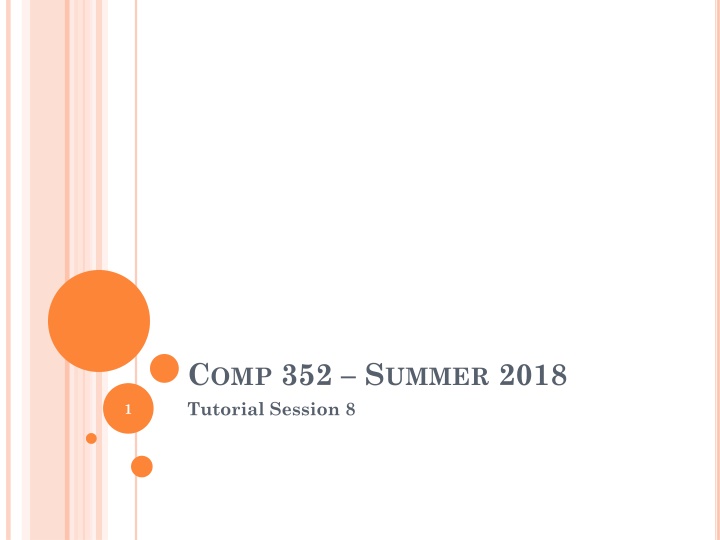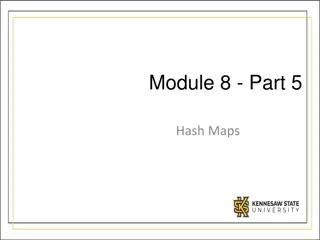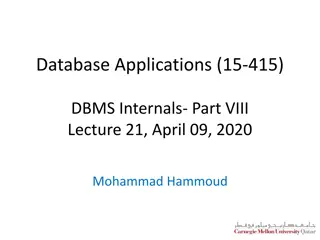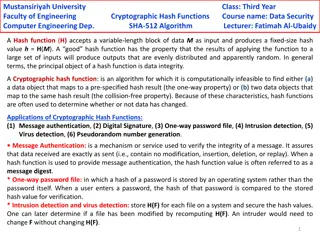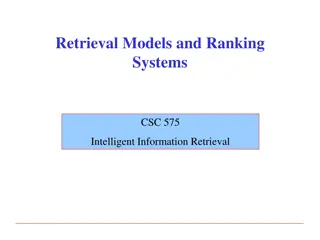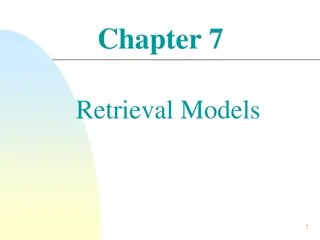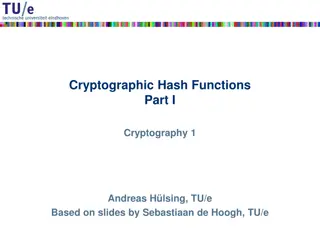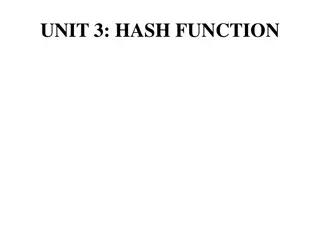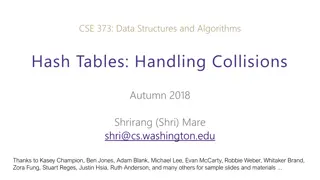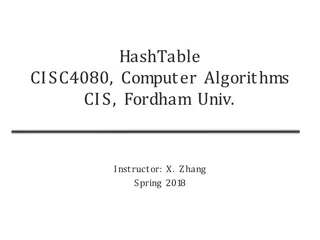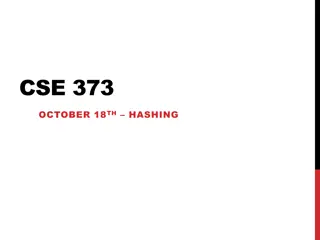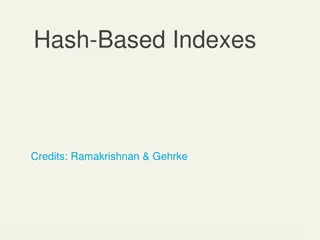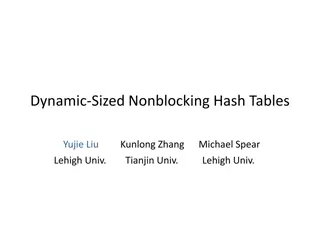Hash Tables: Ideal Data Structure for Efficient Key-Value Retrieval
Hash tables are a fundamental data structure used to fetch key-value pairs efficiently. They involve a hash function to compute an index for storing and retrieving values. Collisions can occur when multiple keys map to the same index. Understanding hash functions and collision handling strategies like separate chaining and open addressing is crucial for optimizing hash table performance.
Download Presentation

Please find below an Image/Link to download the presentation.
The content on the website is provided AS IS for your information and personal use only. It may not be sold, licensed, or shared on other websites without obtaining consent from the author.If you encounter any issues during the download, it is possible that the publisher has removed the file from their server.
You are allowed to download the files provided on this website for personal or commercial use, subject to the condition that they are used lawfully. All files are the property of their respective owners.
The content on the website is provided AS IS for your information and personal use only. It may not be sold, licensed, or shared on other websites without obtaining consent from the author.
E N D
Presentation Transcript
COMP 352 SUMMER 2018 Tutorial Session 8 1
OUTLINE HashTable o Definition o Hash function o Collision Exercices 2
HASHTABLE(1) The ideal hash table(hash map) data structure is merely an array of some fixed size, containing the keys. Besides, A hash table uses a hash function to compute an index into an array of buckets or slots, from which the desired value can be found. It is often used to the situation that we need to fetch the desired key-value frequently. Basic methods: get(k) put(k, v) -- add an entry with key k and value v remove(k) -- remove the key-value entry e. size() 3
HASHCODEANDHASHFUNCTION Function to map the key to an entry in the array of bucket to store the pair (key/value). A hash function is usually specified as the composition of two functions: Hash code: h1:keys integers Compression function: h2: integers [0, N 1], N generally a prime number An example of compression function: h= integers mod N 4
HASH FUNCTIONS -- COLLISIONS One issue with hash tables is how well the Hash Function behaves. That is to say, how well the keys map to integers. When two keys share the same hash value (result of the hash function), we get a collision. A good hash function minimizes collisions under most conditions. The way a hash table implementation handles collisions has an impact on the running time complexity of functions relying on the hash table. 6
COLLISIONHANDLING: SEPARATE CHAINING The first strategy, commonly known as either open hashing, or separate chaining, is to keep a list of all elements that hash to the same value. 0 1 2 3 4 025-612-0001 451-229-0004 981-101-0004 8
COLLISIONHANDLING: OPENADDRESSING An alternative method to resolving collisions. The colliding item is placed in a different entry of the table instead of a linked list. We have different way to deal with collisions. Linear Probing Quadratic Probing Double Hashing The new hash function is: hi(X) = (Hash(X) + F(i)) mod N 9
LINEARPROBING The idea of linear probing is to handles collisions by placing the colliding item in the next (circularly) available table cell. On insert(x), compute f(x) mod N, if the cell is full, find another by sequentially searching for the next available slot Go to h(x)+1, h(x)+2 etc.. In linear probing we have hi(x) = (h(x) + i) mod N (i= 0, 1, 2, ) On find(x), compute f(x) mod N, if the cell doesn t match, look elsewhere. if A[h(k)modN] is already occupied, then try next A[(h(k)+1)modN], A[(h(k)+2)modN], etc. 10
QUADRATICPROBING Resolve collisions by examining certain cells (1,4,9,...) away from the original probe point In quadratic probing we have hi(k) = (h(k) + i^2) mod N, i=1,2,3, .. if A[h(k)modN] is already occupied, then try next A[(h(k)+12)modN], A[(h(k)+22)modN], etc. 11
DOUBLEHASHING uses a secondary hash function h (k) and places the colliding item in the first available cell using the formula hi(X) = (h(x) + i*Hash2(x)) mod N if A[h(k)modN] is already occupied, then try next A[(h(k)+1*Hash2(x))mod N], A[(h(k)+2*Hash2(x))mod N], etc. E.g. Hash2(X) = R (X mod R) R is a prime smaller than N 12
MCQ 1 What is a hash table? A structure that maps values to keys A structure that maps keys to values A structure used to implement a stack and queue Another name for binary search tree a. b. c. d. 13
MCQ3 What can be the technique to avoid collision? Make the hash function to appear randon Use chaining method Use uniform hashing All of the mentioned a. b. c. d. 14
MCQ4 In a simple uniform hashing what is the search complexity? O(n) O(logn) O(nlogn) O(1) None of the above a. b. c. d. e. 15
MCQ 5 Hash table question multiple choice Consider the following hashtable: Index key 0 1 2 20 3 11 4 4 5 6 51 7 6 8 It was created with the hash function H(x) = x % 9 and uses a linear collision scheme. Which of the following was the order in which the elements were inserted to produce the table above? 16
MCQ 5 All of the insert orders listed here will produce the hashtable shown above. None of the insert orders listed here will produce the hashtable shown above. The insert order: 20, 4, 51, 6, 11 will produce the hashtable shown above. The insert order: 20, 11, 51, 6, 4 will produce the hashtable shown above. The insert order: 51, 6, 20, 11, 4 will produce the hashtable shown above. a. b. c. d. e. 17
MCQ 6 Consider the following hashtable: Index 0 1 key 81 10 2 63 3 4 5 14 6 42 7 8 9 It was created with the hash function H(x) = x % 9. Which of the following statements is true about this hashtable? 18
MCQ 6 None of the statements listed here is correct All of the statements listed here is correct The hashtable uses a quadratic collision scheme to handle collisions The hashtable uses separate chaining to handle collisions The load factor of the table (that is nb_elment_in_arr / size_of_array) is 77.77% a. b. c. d. e. 19
EXERCICE o Assume an 11 entry hash table o Use the hash function h(k) = 2k + 5 mod 11 o Insert the keys (k) 12, 44, 13, 88, 23, 94, 11, 39, 20, 16, 5 o Draw the contents of hash table given that for collisions: Chaining is used Linear Probing is used Double Hashing is used with h'(k) = 7 - ( k mod 7 ) 20
